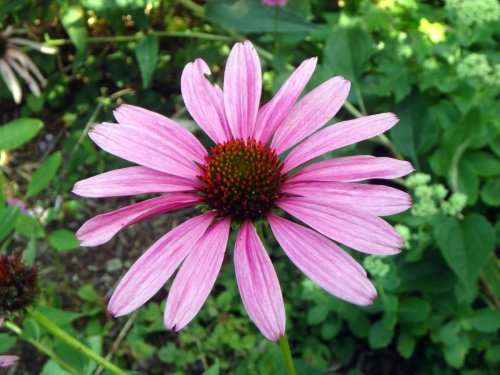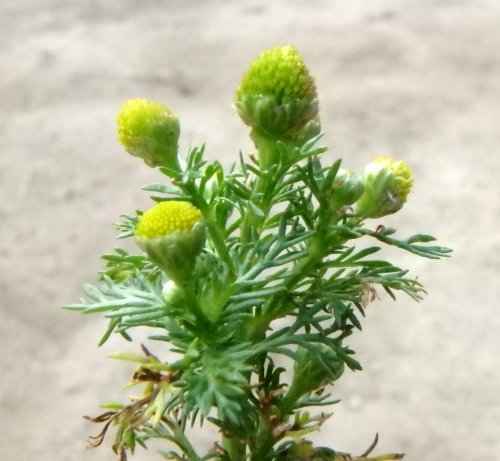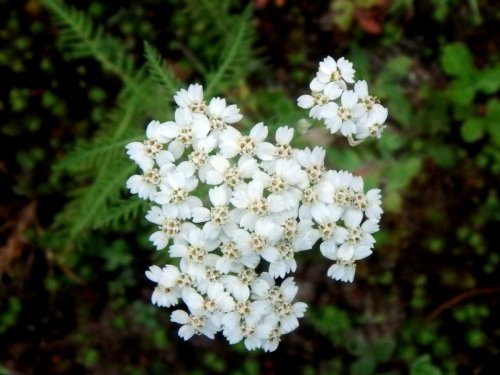It’s time to say goodbye to chicory (Cichorium intybus) I think, though I have seen it blooming in late September before. I found these plants still blooming along a roadside. The flowers were small for chicory at about 3/4 of an inch across, but their beautiful shade of blue more than made up for their small size. Chicory is one of my summer favorites.
I found the first dark purple New England asters (Symphyotrichum novae-angliae) of the season recently. I look for the darkest ones I can find each year and these were beautiful but New England asters are very beautiful, no matter what shade of purple they are. When light and dark flowers grow together the bees always seem to prefer the lighter ones but in this area there were no lighter ones so I had to hope I didn’t get stung. There were bees everywhere, and they were loving these flowers as much as I was.
Most jewelweed (Impatiens capensis) plants are finished for the season but I see them still blooming here and there. This one looked as fresh as they do in July. There are still plenty of pollinators about so I’m sure they’re happy to see more flowers blooming.
Flat topped asters (Doellingeria umbellata) are very tall with large flower heads (panicles) and weak stems, so when all the flowers bloom the stems often bend and the flowers end up at ankle level. This is one of the earlier, more showy asters that spreads by underground rhizomes and usually grows in large colonies of plants. I see them on forest edges.
I liked this pond-side view with its patch of wildflowers blooming.
When our native yellow loosestrifes have all bloomed then it’s time for purple loosestrife (Lythrum salicaria) to start in and despite the belief that they need wet places to grow in I found this river of loosestrife at the edge of a dry cornfield. Purple loosestrife is an invasive that came over from Europe in the ballast of a cargo ship in the 1800s. The beach sand ballast, loaded with purple loosestrife seeds, was originally dumped on Long Island, New York. The seeds grew, the plant spread and now it covers most of Canada and all but 5 of the lower Untied States. Purple loosestrife chokes out native plants and forms monocultures. These colonies can be so large that finding a single plant is becoming very difficult.
Soapwort (Saponaria officinalis) still blooms on the banks of the Ashuelot River. Its common name comes from the way the leaves contain a natural soap called sapronin. When the leaves are crushed and scrubbed together in water a soapy lather forms. In the past this plant was used for washing clothes and making soap. It hails from Europe and though it is used medicinally it is considered toxic. It was originally introduced as a garden plant and promptly escaped.
Though its flowers resemble those of boneset, which flowers at the same time, white snakeroot’s (Ageratina altissima) large heart shaped, toothed leaves look nothing like boneset leaves. This plant is very toxic and in the early 19th century it killed thousands of settlers in the Midwest. A compound called trematol is passed from the plant to cows that graze on it and when humans drank the milk before too long they started to show signs of what was called “milk sickness.” In a week or less most would die of heart or liver failure. Abraham Lincoln’s mother died from milk sickness when he was just 9 years old. All parts of the plant are toxic to cattle, horses, sheep, and humans. Today’s farmers eradicate the plant from their pastures and mix the milk from many cows together, so milk sickness is almost unheard of. A Native American woman from the Shawnee tribe is credited with finally warning settlers about this plant and most likely saving thousands of lives.
Individual white snakeroot flowers are small, bright white, and fuzzy. The plant seems to prefer moist, shaded locations and doesn’t mind disturbed ground. It can often be found quite deep in forests and blooms from August to September. If you should happen to have farm animals you should know it well.
It’s also time to say goodbye to the purple coneflowers (Echinacea purpurea.) This one looked like it had been through the wash. Its color had faded and its dry petals felt like paper.
Pretty little blue toadflax (Nuttallanthus canadensis) must be one of the longest blooming wildflowers we have here. It usually starts blooming in May and I’m still seeing it in quite large numbers here in September. You can’t ask more from a flower than that. I love the shade of blue that it wears.
There are about 15 different species of agrimony but I think this one is woodland agrimony (Agrimonia striata.) The small, bright yellow flowers grow in long spikes (racemes) on a small, knee high plant. The last time I showed its flowers I forgot to show the foliage, so this photo corrects that oversight. If you know it as something other than woodland agrimony I’d love to hear about it.
Woodland agrimony is also called roadside agrimony, and that is just where this one grew. Agrimony has been used medicinally for many thousands of years, dating back to at least ancient Egypt, but though woodland agrimony is native to the U.S. and Canada I can find no information on how it was used by Native Americans.
I saw these beautiful chive blossoms in a friend’s garden. I think they must have been garlic chives (Allium tuberosum.)
Native hog peanut (Amphicarpaea bracteata ) flowers are small and beautiful, but it’s a plant that comes with a lot of baggage. As the story goes author and forager Samuel Thayer calls them ground beans rather than hog peanut because he claims that the name “hog peanut” was a racial slur against Native Americans. He says that the Europeans came to a point where they refused to eat them because even though the small legumes saved many of their lives they insisted they were only fit for hogs (implying that Native Americans were hogs.) Personally I find this story hard to believe because anyone who has ever raised pigs knows that they root around in the soil looking for just the kinds of legumes that grow on these vines, and it isn’t hard to imagine colonials, who raised pigs, saying “look, the hogs have found some peanuts.” I call it hog peanut here not to slander anyone but because nine out of ten people will use a plant’s common name when they look for it in field guides, and field guides call the plant hog peanut. If Samuel Thayer can get them to change that, then I’ll be happy to call it a ground bean.
Like a true peanut, after pollination some of its flowers bury themselves in the soil and form a small, edible, bean like seeds that give the plant its common name. Mice collect these seeds and store them in large caches that Native Americans used to search for. They can be eaten raw or cooked. The plant also forms inch long, pea-like, above ground pods that contain three or four inedible seeds. Hog peanut is a strong, wiry vine that can cover large areas of forest floor and choke out other plants. It is also good a tripping up hikers.
I tried many times to get a photo looking into these tiny but pretty flowers, but this is the best I could do.
The little lobelia called Indian tobacco (Lobelia inflata) blooms quite late but is almost finished for this year. Its small flowers are about 1/3 of an inch long and pale lavender to almost white. It is the only lobelia with calyxes that inflate after the flowers have fallen and to identify it I just look for the inflated seedpods.
The little lobelia called Indian tobacco gets its name from the way its inflated seed pods resemble the smoking material pouches that Native Americans carried. The inflata part of its scientific name also comes from these inflated pods. The pods form so quickly that they can usually be found on the lower part of the stem while the upper part is still flowering.
I don’t know if this was tall goldenrod (Solidago altissima) but it was a tall goldenrod that stood feet above the other plants in the surrounding meadow. Its height was amazing.
I tried and failed to get a shot of a single goldenrod flower for you, but it’s close. I think there are two here.
One of the things I like most about native pineapple weed (Matricaria discoidea) is the way a child’s face will light up and break into a smile when they crush it and smell it. Usually when I tell them that it smells like pineapple they don’t believe it, so it’s a surprise. The conical flower heads are easiest to describe by saying they’re like daisies without petals, or ray florets. The flowers are edible and can be used in salads, and the leaves are also scented and have been used to make tea. The plant was used by Native Americans in a tonic to relieve gastrointestinal upset and fevers. The Flathead tribe used the dried, powdered plants to preserve meats and berries. It is said to make a nice pineapple flavored tea.
Yarrow (Achillea millefolium) starts blooming usually in June and then takes a rest in the heat of summer before re-blooming when it cools off again. Its flowers are sparse at this time of year but I find it blooming here and there. Humans have used this plant in various ways for thousands of years. It is mentioned in the Chinese I Ching, which is said to pre date recorded history, and it has been found in an excavation of a Neanderthal grave site. Yarrow was known as the soldier’s woundwort and herbe militaris for centuries, and was used to stop the flow of blood. It was a valuable healing herb, one of the nine “holy herbs,” and was traded throughout the world since before recorded time, and that is believed to be the reason for the plant being found in nearly every country on earth today. Native Americans used it for everything from snake bites to deodorant.
What a desolate place would be a world without a flower! It would be a face without a smile, a feast without a welcome. Are not flowers the stars of the earth, and are not our stars the flowers of the heavens? ~ A.J. Balfour
Thanks for coming by.






















